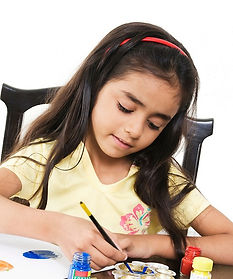VE ART Studio
About
Art is Man's nature. Nature is God's art. ~James Bailey
Art is FUN!
It's important to balance fun, creative activities with technique building exercises, avoiding boredome while developing skills. Traditionally art teaching for children has emphasised self-expression, avoiding skills for fear of cramping creativity. But basic skills can be enjoyable to work on, and stronger skills allow students to more fully express their ideas.
VE ART Studio Mission
1. To teach a quality program from which students enjoy learning the skills necessary to draw, paint, and create three-dimensional art realistically, progressing step-by-step at their level of ability, to become more competent and skilled at every level of the VEART program.
2. To provide a warm and friendly environment in which inspirational teachers excel at helping, encouraging, and challenging each student to reach his or her individual, artistic potential.
3. To provide service that is helpful, cheerful, and caring; creating a comfortable atmosphere that puts our families at ease.



Mediums taught.
When you teach the visual arts you are really developing an individual's ability to see (perceive) relationships; in other words to measure accurately one thing to another.
The word art, from its Latin/French base literally means "to fit together." Examining this meaning, we can see that drawing and painting can be likened to cooking. Just as the culinary artist fits together ingredients (parts), so does the visual artist. In order to make a drawing of an object or thing, one needs to see its individual sections (how it is constructed). To draw, a person learns to examine and isolate each part back into a whole.
DRAWING / SKETCHING
The basic introductory format is composed of three essential components of visual art:
1. Form (shape)
2. Size (mass, scale)
3. Composition or Placement (relationships)
WATERCOLORS
Watercolors have been used throughout history, but have steadily gained popularity since the 1800's in England.Watercolors are finely ground pigments mixed with a binder, allowing artists to achieve (among other techniques) luminous, sketch-like effects.
ACRYLIC PAINTING
The impetus for the invention of artistic media has been the search for permanency and durability. Generally, the solid pigment or coloring agent is the same in all paints. The variable, and that which gives each paint its distinct characteristics, is the liquid binder or vehicle. Materials such as water, oil, or egg yolk holds the color so that it can be spread along a surface.
The binder in acrylic paint is a plastic; a synthetic. Therefore, acrylics dry quickly and are water soluble. This allows clean-up free from the disadvantageous smell of other media.
OIL PAINTING
Oil paint is named for the binder in which the pigment is suspended. This liquid is made from the ground seed of the flax plant called linseed oil. Its use began in the 15th century and was most assuredly heralded as a major event. Oil paint is extremely flexible and when thoroughly dry is rock hard (durable); two characteristics of paint desperately sought after, by generations of artists. Further inventions such as canvas and tube color have little changed the basic innovations of oil painting. It became, and remains for many, the perfect medium.
Testimonial
Questions? Please contact us!

